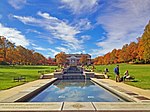Adele H. Stamp Student Union
School buildings completed in 1954Student activity centers in the United StatesUniversity of Maryland, College ParkUniversity of Maryland, College Park facilitiesUniversity of Maryland, College Park student organizations

The Adele H. Stamp Student Union, commonly referred to as "Stamp", is the student activity center on the campus of the University of Maryland, College Park. First constructed in 1954 (with additions in 1962 and 1971), the building was renamed in 1983 for Adele Hagner Stamp, who served as the university's dean of women from 1920 to 1960. Stamp houses nearly all of the university's student organizations, and is considered the "center of campus life," receiving more than 19,000 visitors daily.
Excerpt from the Wikipedia article Adele H. Stamp Student Union (License: CC BY-SA 3.0, Authors, Images).Adele H. Stamp Student Union
Campus Drive, College Park Old Town
Geographical coordinates (GPS) Address Phone number Website External links Nearby Places Show on map
Geographical coordinates (GPS)
| Latitude | Longitude |
|---|---|
| N 38.988 ° | E -76.945 ° |
Address
Adele H. Stamp Student Union
Campus Drive 3972
20742 College Park, Old Town
Maryland, United States
Open on Google Maps







